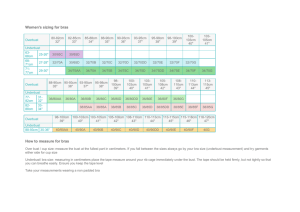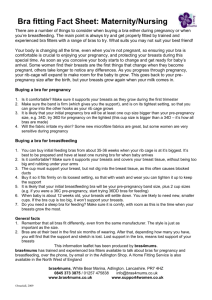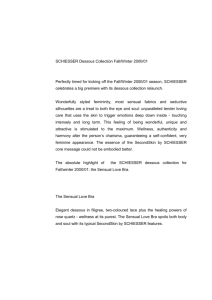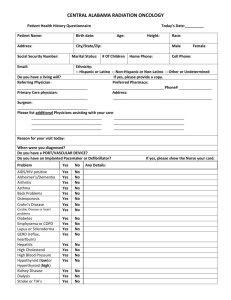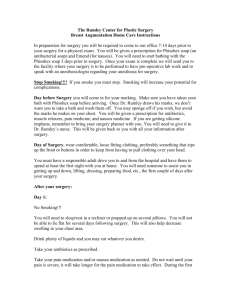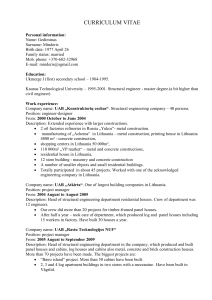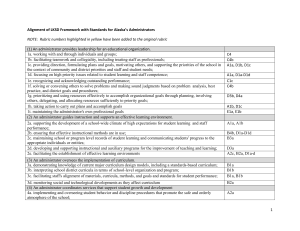DONlT GO BRA SHOPPING WITHOUT IT!
advertisement
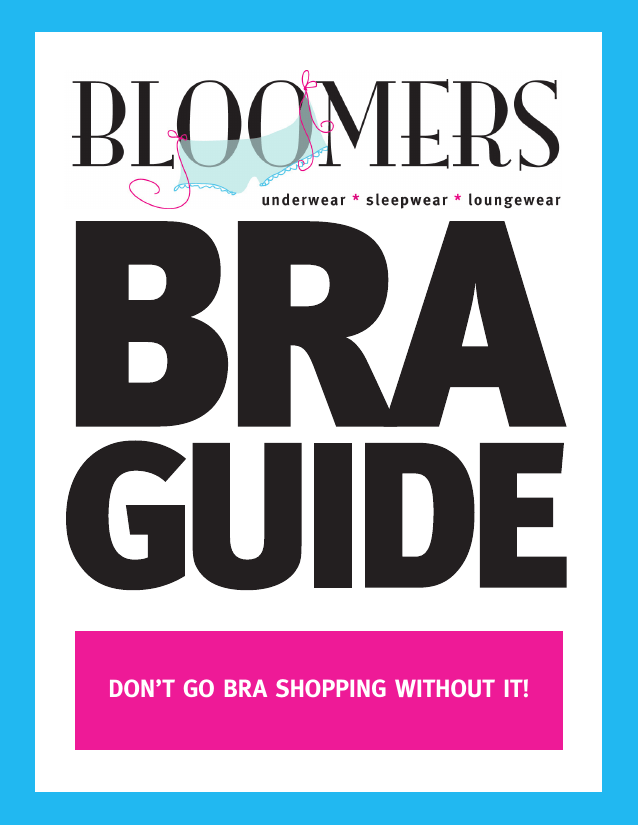
Don’t go bra shopping without it! We ’ve heard it many times…most women are wearing the wrong bra size—whether it be the wrong band size, the wrong cup size, or both. Brassieres (more commonly referred to by the abbreviated term: bras) were widely adopted in the 19th century. The bra was originally invented with the primary purpose of enhancing the wearer’s comfort by supporting her breasts. Since their conception, bras have been altered, adorned, amplified and altogether advanced to fulfill every function of female—and sometimes male—interest whether it be to lift, tuck, separate, push-up, even-out, or nurse. But no matter the additional features, a bra must fulfill its original, primary purpose of providing comfortable support for the wearer. At Bloomers, we believe that bra buying shouldn’t be a heartwrenching experience. Finding the right bra for you isn’t as intricate an equation as some may assume. This guide is intended to enlighten customers on brassiere basics to help ensure you choose the right bra. The first step in reaching your nirBrana is to get measured. Remembering that the primary purpose of a bra is to provide comfortable support, we highly recommend that you be aware of your current bra size. If it has been a particularly long time since you’ve been measured, it is important that you get re-measured because your bra size will fluctuate with weight changes and body changes such as pregnancy and breastfeeding. Think of it this way: you wouldn’t shop for pants without your pant size in mind. However, similarly to pants, bras may fit differently depending on brand, style or cut. Nevertheless, an accurate measurement is the best possible place to begin. All Bloomers associates are professionally trained to measure customers for their accurate bra size. But if you don’t have the pleasure of stopping by one of our Bloomers locations, keep this guide with you to answer your most common undergarment inquiries. Bra Styles Bras have been developed for a plethora of purposes. With so many styles available, finding the right bra to meet your specific set of needs may seem a bit daunting. To help decipher the language of bras, we’ve compiled a list of the most common types of bras, defined. Learn the right vocaBralary to use for every style, fit and intended purpose. Adhesive—These are simply bras that stick to you. Great strides have been made in adhesive technologies allowing many of these bras to be worn over and over again. These are great for backless and strapless outfits. This is a special occasion bra, not an everyday bra, because they don’t often offer a lot of support. Balconette—Also known as the shelf bra. The balconette is a littler version of the demi. It offers little to no coverage and creates a “balcony” type shape to your breasts. The purpose of this bra is to lift the breasts and enhance their shape and cleavage. Bandeau—This is simply a band of material that is worn straight across the breasts. While they sometimes have built-in cups, they do not provide support or shaping. These types of bras offer a great solution to a deep neck line or a top with large openings in the sleeves. Bralette—A soft cup, no wire, unlined pullover style bra. These provide no support but do provide a lot of comfort. They are excellent and designed primarily for smaller breasts. Contour—This is also known as the molded cup or T-shirt bra. These bras have seamless, preformed foam cups. The cup helps to define shape. These bras are great for breasts that may be asymmetrical since the cup shape doesn’t collapse when not worn or filled. Demi—This bra is just as it name infers…it is demi, small or half. It is a partial cup bra that covers about half to three quarters of the breast. Its primary purpose is to create cleavage and lift. With this type of bra, the straps are usually attached to the outer edge. So, it might not be the best choice if you are wearing a racerback top. Convertible—No, this doesn’t mean it is a bra whose top is down. A convertible bra means it has alternatives or can be converted. Straps on convertible bras can be rearranged in different ways to accommodate multiple fashion trends. For example, convertible bra’s straps can often be changed from a typical over the shoulder bra to criss cross in the back to accommodate a racerback top, go around the neck for a halter, be removed to be strapless, or go over one-shoulder. Full Cup—This type of bra offers maximum support and full coverage for the entire breast area. This is also known as a practical bra for large busted women. While it may not always be the prettiest to look at it, they often are the best choice under clothing. Maternity—This bra offers a full cup and wider shoulder straps to provide maximum support during pregnancy. Some maternity bras are adjustable to allow the cup size to expand as the breasts grow during pregnancy. Minimizer—Its name says it. This bra minimizes the breasts. It de-emphasizes the breast area by compressing the breasts against the body. You have to be careful with minimizers though. Some can create a uni-boob look. Nursing—This bra makes breastfeeding easier and more convenient. With flaps or panels that can be unclipped and folded down, it makes it easier to expose the breast during breastfeeding. These bras are wireless intentionally. Underwire is not recommended while nursing because it can restrict the flow of milk and cause mastitis. Padded—This bra type offers extra padding to give the perception of a larger bust size. The cups are thicker and there are often shape enhancing inserts or foam padding inside the lining of the pad. An important distinction between the padded bra and the push-up is that the padded bra is not intended to increase cleavage. Plunge—Take the plunge if you need a bra to follow a lower neck line. These bras plunge down the front to allow for lower and increased cleavage. These bras are designed with cups that are more open and lower in the center. Shoulder straps can also be set widely apart, like the demi bra. These bras are not usually heavily padded like a push up bra. Push Up—This is the sister bra to the demi. Unlike the demi, this type of bra is not usually half in size. This bra is supported by extra, angled padding in the cups along the lower outer edge of the breast. It seeks to create the appearance of increased cleavage by lifting and pushing the breasts upward and inward. Racerback—These bras have shoulder straps that form either a V or a T in the back instead of traditional over the shoulder straps. This design also provides a bit of extra support. Soft cup—Quite simply, this is a non-underwire bra. While soft cups are usually considered bras without support, new technologies and bra designs give these bras better support than ever. Spacer—This is a newer style of bra. It is best known as a smooth T-shirt bra but it has an important difference from a typical T-shirt bra. Spacer bras are constructed of a dual layer foam fabric and are light and airy. Unlike typical dense padded bras, spacers are formulated with a honeycomb weave that allows the skin to breathe and keep cool. While the bra’s padding may seem too light to provide support, it is actually stronger than its counterparts. Embrace the spacer. This is cool bra technology. Sports—This is a bra specifically designed to provide firm support and minimize breast movement during athletic activities. Most are suitable for every type of athletic activity ranging from yoga to running. While a sports bra is designed with racerback strapping to provide maximum support, these bras are not the same as a racerback bra described above. Also, a sports bra is typically made of a fabric to wick away moisture from the skin and reduce irritation. Bra Sizing Guidance Getting measured and determining your bra size is not an exact science. Your size may vary depending on brand and type of bra. Shhh! This is a secret that many bra stores don’t want you to know. But, it’s true! All brands are cut differently and all styles fit differently (see previous page). So, use the measurement as a starting point and be open-minded to trying on sizes up and down the band and cup spectrum depending upon the brand or style. Before getting into the process of finding your bra size, it is important to note a few fundamentals. Mass-produced bras are fitted for a prototypical woman with the assumption that both breasts are equally sized and positioned. Thus, finding a good-fitting bra for your body can be a challenge since not all breasts are made equal and most bras are. Most manufacturers’ measurements don’t account for the fact that the size and shape of women’s bodies and breasts vary widely. Also, you’ve probably encountered this…there are different sizing systems in different countries. The most notable difference is in cup sizing, particularly larger cup sizes. The following are the most common differences in cup sizing that you will come across. Also, what most people don’t realize is that a bra cup size is relative to the band size. So, in fact, an A cup on a 30 band is not the same size as an A cup on a 36 band. Cup Sizing A B C D DD DDD G A B C D E F G Finding your measurement It is important to point out that there are multiple techniques to finding your bra size. The following approach is not the only one and, as said previously, it is very important to remember that by finding your bra size, you are finding the starting point in which to narrow down your search. All brands and styles fit differently and finding the perfect fitting bra really needs to be done with an open mind. Step 1: Finding Your Band Size. Measure under the bust. Be sure to measure right under your bust along the area that your bra band would typically sit. If the measurement is even, add 2 inches. If the measurement is odd, add 3 inches. The reason for this is because bra band sizes are sized in even numbers. The result is your band size. Step 2: Next, measure around the fullest portion of the breast, across the nipples. Record that measurement. IF THE DIFFERENCE IS: 0"–1/2" 1/2"–1" 2" 3" 4" 5" 6" Step 3: Finding Your Cup Size. Subtract the step one measurement from the step two measurement. Plot the difference on the chart below to find your cup size. STANDARD CUP SIZE IS: AA A B C D DD/E DDD/F Tips for a Good Fitting Bra Lastly, once you think you’ve determined your size and found the style of bra you like, check the following to ensure a good fit: 1. The band should be positioned perfectly horizontal across the back. It should not ride up or down along the back. It should not be too tight, squeeze the flesh, or leave indents in your skin. 2. Straps should be adjusted accordingly to ensure the band runs perfectly horizontal across the back. Straps should not dig into your shoulders either. This could be a sign that the cup size is incorrect. (Thankfully, many bra companies are now making comfort straps to help lessen the digging.) 3. Breasts should not overflow out the sides of the cup (under the armpits), or in the front cleavage area. This is an indication the cup is too small and can cause noticeable “cuts” or protrusions under clothes. If you are unsure if a cup fully covers your breast, try on a tight camisole or t-shirt to check if there is any apparent unevenness. 4. The underwire should lay flat against the body on the breast bone, not the breast itself. Make sure this is true on both sides. 5. The bridge (or area between the cups in the front) should lay flat between the breasts. 6. Most importantly, find a bra that is comfortable! We like to tell our customers, when trying a bra, to wiggle around and put your hands over your head and sideways to make sure the bra feels comfortable when performing normal tasks. A good fitting bra will also ensure that the clothes you wear look better than ever. At the end of the day, it’s underneath that really counts. BLOOMERS 924 King Street, Alexandria VA 22314 Tel. 571.312.0852 4150 Campbell Avenue, Arlington VA 22206 Tel. 571.970.4756 www.shopbloomers.com
